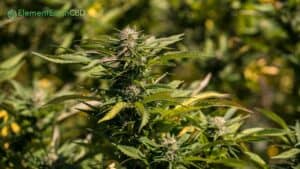CBD Glossary
—A—
Anandamide
A major endocannabinoid naturally found in the body. Anandamide is part of the body’s endocannabinoid system and alters functions like cognition, learning, memory, mood, other higher intellectual functions, and certain motor functions. THC is thought to produce psychoactive effects and alter these same functions in the body because it mimics the way anandamide interacts with the endocannabinoid system.
—B—
Bioavailability
This term refers to the degree and rate at which a drug is absorbed by the body’s circulatory system. It’s an important measurement tool because it determines the correct dosage for non-intravenously administered drugs. For drugs, supplements, and herbs administered non-intravenously (such as through consumption, inhalation, or topical application) bioavailability designates the fraction of the ingested dose that eventually gets absorbed.
Broad spectrum
Products labeled “broad spectrum” fall somewhere between full-spectrum and isolate formulations. Because they contain terpenes and other beneficial cannabinoids, broad-spectrum products offer some of the benefits of the entourage effect — without any THC. For those who can’t have or don’t want to have any traces of THC in their system, broad-spectrum products can be a better choice than isolates. But they’re not as effective as full-spectrum products.
—C—
Cannabidiol
Also known as CBD, cannabidiol is one of the naturally occurring cannabinoids found in cannabis plants. It’s the second most prevalent active ingredient in cannabis, accounting for up to 40% of the plant’s extract. CBD does not produce psychoactive effects. Cannabidiol interacts with the endocannabinoid system (ECS), part of the nervous system that’s thought to play a regulatory role in all kinds of bodily functions, including mood, sleep, and appetite.
Cannabinoid
Not to be confused with cannabidiol (cannabidiol is a cannabinoid, but not all cannabinoids are cannabidiol), a cannabinoid is one of the diverse chemical compounds that acts on the endocannabinoid system receptors found throughout the body. These molecules include the endocannabinoids produced naturally in the body and phytocannabinoids from cannabis. The two most notable cannabinoids are THC and CBD.
Cannabis sativa
Indigenous to eastern Asia, this flowering herbaceous plant has been farmed throughout recorded human history. It is farmed for marijuana as well as the industrial hemp used in CBD products. In addition, hemp fiber, hemp seed oil, and food products are also derived and harvested from different parts of the plant.
Capsule
A delivery method for CBD oils and extracts that’s easy to swallow (literally). Capsule products resemble the gel pills you’re used to seeing at your local pharmacy.
CBD
Cannabidiol’s popular nickname. You’ll see CBD attached to many products, but not all are created equal.
Certificate of analysis
A document from an accredited laboratory certifying the amount of cannabinoids in a given product. This proof of analysis exists to benefit the consumer as much as the producer: It guarantees quality assurance for both parties. Reviewing the COA is a pro consumer move that helps you avoid mislabeled, low-quality, or fake products. A reputable company will always provide one.
CO2 extraction
The carbon-dioxide extraction process uses changes in temperature and pressure to create phase changes in carbon dioxide, gently drawing out the plant’s beneficial components. The result is clean, safe oil with a long shelf life.
—D—
Delivery method
How a drug enters the body in order to produce the desired therapeutic effects. The delivery method of a given drug can affect how quickly it starts working and how much of each dose gets absorbed by the body (bioavailability). CBD delivery methods include ingestible capsules, gummies, and tinctures, as well as topical lotions, salves and lip balms.
Delta-9 tetrahydrocannabinol
Known by the abbreviation THC, this is a primary cannabinoid found in cannabis and the one responsible for its psychoactive effects. It works on endocannabinoid receptors in the brain to release dopamine. Some dislike the “high” feeling or other side effects of this chemical and prefer hemp-based products that contain very little to no THC.
—E—
Edible
Any food containing some form of cannabis. Pot brownies are the most classic example, but nowadays, cannabis-infused edibles come in many other forms: candy, coffee, baked goods, martinis, even infused butter and cooking oil.
Endocannabinoid system
Also known as the ECS, the main function of this mammalian system is to maintain bodily homeostasis, or keeping the body balanced even when the environment changes. Scientists believe that cannabis is effective, in part, because the phytocannabinoids it contains mimic our endocannabinoids. Endocannabinoid receptors are found throughout the entire body, and the system plays a part in many of the body’s processes, including appetite, stress, sleep, pain, memory, and immune function.
Learn more: Human Endocannabinoid system
Entourage effect
This phenomenon is all about teamwork: It’s the result of the many components in the cannabis plant interacting together with the human body to produce a stronger effect than any one component on its own. Full-spectrum CBD products combine CBD with other naturally occurring terpenes and cannabinoids (including THC) to be more effective than their isolate counterparts.
Ethanol extraction
Extraction using cold, high-grade alcohol gently pulls all the active compounds from the cannabis plant’s cellulose material, resulting in pure, full-spectrum hemp oil. Oils extracted using this method are further refined via chromatography to remove all remaining traces of ethanol.
Extraction
The process of deriving CBD oil from hemp. There are several methods of extracting CBD from cannabis plants, including CO2 and cold ethanol extraction.
—F—
Farm Bill
United States Congress voted at the end of December 2018 to pass the Agriculture Improvement Act of 2018, more commonly referred to as the Farm Bill. This legislation made CBD products legal to purchase in all 50 states. Under the Farm Bill, industrial hemp (where CBD products are derived from) must contain less than .3 % THC. The power over industrial hemp regulation is shared by the state and federal governments. The Farm Bill also gave the FDA the authority to regulate cannabis products.
FDA
The U.S. Food and Drug Administration (FDA) is a regulatory government agency with the power to regulate cannabis and cannabis-derived products since the passing of the 2018 Farm Bill. So far, the FDA has officially approved the CBD product Epidiolex as a treatment for epilepsy. The government’s relationship with the cannabis industry is constantly evolving; learn more about about how the FDA is handling cannabis and CBD products on the FDA’s website.
Full spectrum
CBD that’s full of all the terpenes, cannabinoids, flavonoids, and fatty acids found in hemp, all of which have therapeutic value of their own and help create what’s known as the entourage effect. Basically, full-spectrum CBD can give you every potential benefit the plant has to offer.
—H—
Hemp
A distinct strain of the Cannabis sativa plant often grown for industrial use. Hemp used in CBD products must contain less than .3% THC.
Hemp seed oil
Derived from industrial hemp, hemp seed oil is created by pressing the plant’s seeds. It has no therapeutic benefits but is often used as a dietary supplement and a low-saturated-fat cooking oil.
—I—
Industrial hemp
Hemp grown specifically for the industrial uses of its products, including textiles, clothing, biodegradable plastic, food, biofuel, and medicine (including CBD). Hemp and its products are legal in the U.S. under the Farm Bill as long as they contain less than .3% THC.
CBD Isolate
These products are 99% CBD. To manufacture an isolate, everything contained in the plant matter is removed — including any traces of THC and other beneficial cannabinoids — until only a powder or crystalline form of CBD is left. This means that isolate users will not benefit from the entourage effect.
—M—
Marijuana
A general term that refers to female Cannabis sativa plants that produce flowers containing phytocannabinoids that are used for their medicinal and psychoactive properties.
Microdosing
A technique that involves consuming small servings of CBD supplements throughout the day. Microdosing can be beneficial because it allows the user to maintain stable CBD levels in your system around the clock. This consistency can be important for those who use CBD for its balancing properties.
—N—
Nutraceutical
Also known as dietary supplements, these are food-derived products that offer extra health benefits in addition to their existing nutritional value. These products that contains nutrients derived from food products and are often concentrated in liquid, capsule, powder, or pill form. Dietary supplements are regulated by the FDA.
—O—
Organic
Foods and products derived from farming methods that promote ecological balance and restrict the use of pesticides, fertilizers, and synthetics. These growing practices promote the health of both the environment and the consumer. Organic products particularly appeal to those who support sustainable farming and care about the safety and quality of what goes into their bodies.
—P—
Phytocannabinoid
The chemical compounds in cannabis plants that mimic the endocannabinoids naturally produced by the body. CBD and THC are examples of phytocannabinoids, but there are at least 113 different phytocannabinoids in the cannabis plant, each producing unique effects in the body.
Potency
A measure of drug activity expressed in terms of the amount required to produce an effect of given intensity in the body. A high-potency drug evokes a larger response even at a low dose, while a low-potency drug evokes a small response at low concentrations and requires higher doses for a similar effect.
Psychoactive
A property that changes brain function by interacting with the central nervous system and results in altered perception, mood, consciousness, cognition, or behavior. THC is the primary psychoactive component in cannabis plants.
—S—
Salve
An ointment made from the cannabis plant to be applied directly to the skin.
Strain
A cannabis plant bred for certain characteristics and use in medicinal, recreational, or industrial purposes. Industrial hemp, for example, is a strain bred to contain more CBD and less THC than other varieties, making it useful for medicinal products and legal under the Farm Bill.
Sublingual
From the Latin for “under the tongue,” a method for administering drugs by mouth. It involves placing a substance under the tongue, where it can be readily absorbed into the blood vessels and begin to circulate throughout the body.
—T—
Terpene
Aromatic oils that lend flavors such as berry, mint, and pine to different cannabis strains. More than 100 different terpenes have been identified, and every cannabis strain has its own terpene profile. The effects of any given terpene may be amplified in the presence of other compounds (also known as the entourage effect).
Learn More: What Are Cannabis Terpenes and What Do They Do?
Tincture
A delivery method, typically administered sublingually, that quickly absorbs and distributes throughout the body.
Topical
A delivery method where product is applied to the skin, typically as a salve or lotion, over the areas where they’re needed.
Learn More: Full Spectrum CBD Lotion, Full Spectrum CBD Salve
—V—
Vertical integration
A business practice where a company owns its own supply chain. For example, owning the farms where hemp is grown, the barns where it’s stored, and the labs where it’s processed. This means that a vertically integrated company can ensure tighter quality control and maintain their core values and practices across all parts of the production process.
Latest CBD Information
How Live Resin Can Transform Your Vaping Experience
-
Posted by
James Lazos
How Ruby Kush from Vance CBD Flower Can Enhance Your Daily Routine
-
Posted by
James Lazos
Among the myriad of CBD products available, Vance CBD Flower’s Ruby Kush strain stands out as a premium option for enhancing your daily routine.
Boost your morning routine: Exploring Snoozy New Morning Highs Gummies
-
Posted by
James Lazos
Snoozy New Morning Highs THC/CBG Gummies are your perfect morning boost. Explore how they energize your day with a balanced blend of THC and CBG in every bite!
Discover the Zen of Hybrid Gummies: All-Natural, Vegan, and Gluten-Free THC Edibles
-
Posted by
James Lazos


